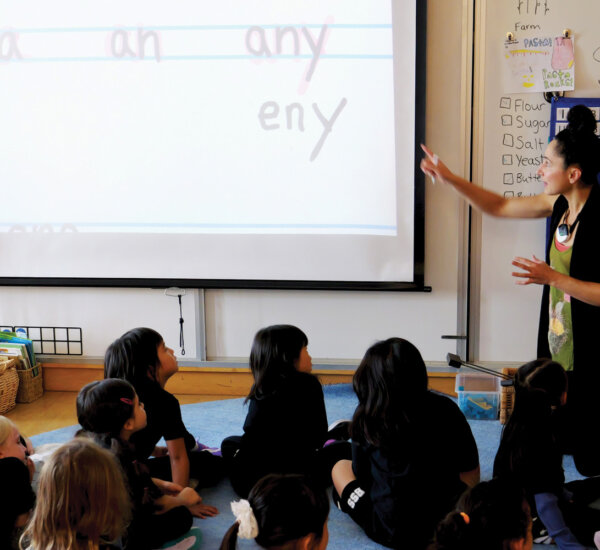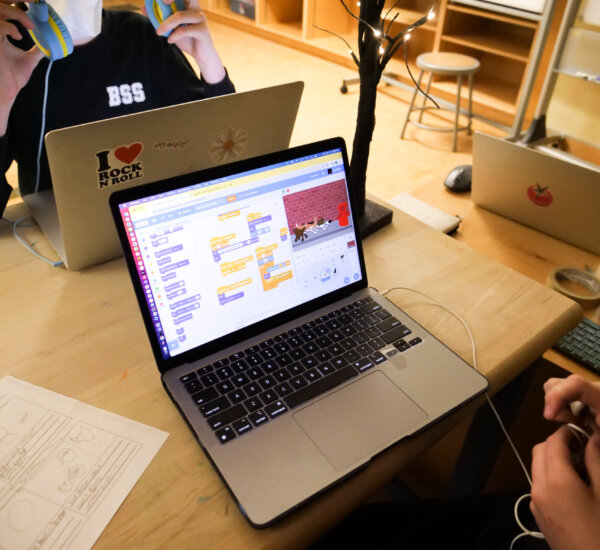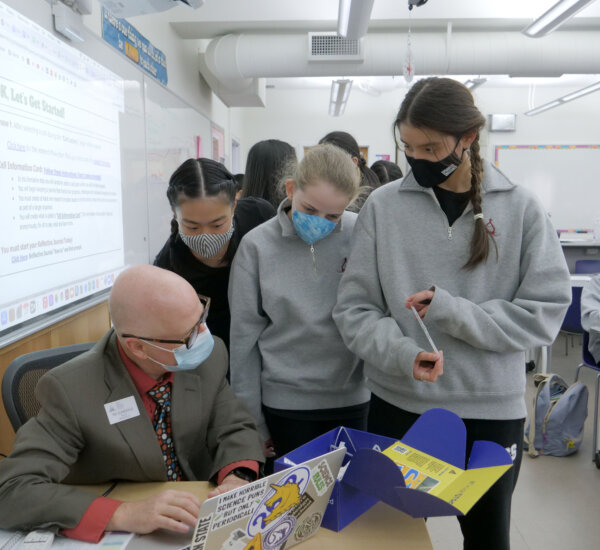When Middle School students lined the stage last November to recreate the absurdist world of Wonderland for the play Through the Looking Glass, the gravity defying flowers and giant toadstools surrounding them were a product of STEM learning in their classrooms.
STEM learning is the study of science, technology, engineering, and mathematics, including cross-curricular and/or integrative study, and the application of those subjects in real-world contexts. For the play, Middle School students applied their understanding of design thinking, innovating, use of the scientific method, scientific inquiry skills, and engineering design skills to create the whimsical world of Wonderland.
Inquiry promotes purposeful learning through the investigation of complex questions and problems, and learning by actively engaging in projects allows students to contribute their strengths, develop new skills, and visibly see the outcome in the product they have created.
Learning Gravity, Form and Function
Between October and November, all Grade 7 students were assigned props to build for the play. With the support of Middle School mathematics and science teachers Sarah Crump and Winnie Muirhead, associate teacher Diana Kim, and design and technology specialist Jordanne Chan, students tested their math and science learning at every step. Students began by sketching out ideas and including measurements for each item that would adorn the stage. To build props, students tested specific mathematical and scientific knowledge, such as centre of gravity, symmetry, form and function, and conversion.
“By gaining foundational knowledge about structures in prior classroom activity, students were effectively able to apply that knowledge in tangible, hands-on ways while building props. They also had to puzzle out problems such as how to make a headband support a number of weighty petals or how to make a wire support a metal teacup for a gravity illusion,” says Ms. Chan.
Then, with support from the Design Technology lab, students used suitable materials like power tools, coping saws, drills, jigsaws, and heat guns to build prototypes of the props. From wood to cardboard to polymer clay, recycled paper and felt, students considered what materials would best work for each prop. Equinox, a Grade 7 student who also worked as lead designer of the play, weighed these options when building a giant flower prop, which needed to be light but sturdy: “I had to figure out how to make sure it stood up straight. So, I used cardboard and had to use beams of wood at the base.”
Students were also asked to consider the structure of the prop, what type of material would best support it, and how it would fit into the production of the play. This challenged students’ understanding of the internal forces of a structure, like gravity. One Grade 7 Student, Angelie, noted that when designing a rose costume for the play she “needed to figure out what the structural basis of support would be because it needed to stand on its own.”
Thinking Like Scientists
While STEM learning occurs in the classroom, tasks like this require students to think about how what they’ve learned applies in real-world situations. “We’re talking about civil engineers building a room, and to do that, they need to know the surface area. They need to know the area and the weight of the materials. And that’s the application of math learning,” says Ms. Muirhead.
A previous project called Clean Teeth, where students designed environmentally conscious toothbrush packaging, served as a precursor to the more complicated project of building out Wonderland. Ms. Crump describes the project as a full STEM integration project, because it required students to build on their understanding of mathematical and scientific concepts like chemical composition and surface area. Students were asked to consider the size and shape of their prototypes, as well as the materials they chose to make them. For example, students learned about different types of plastics, their chemical properties, and how likely they are to biodegrade.
“We have toothbrushes in the classroom, and they’re measuring the length, the width, the height,” says Ms. Crump. “And then in science, we’re learning about materials. So they’re going to learn, for example, that some plastics take 450 years to biodegrade.”
During the Clean Teeth project, students engaged in the Engineering Design process, which involves defining the problem they are being asked to solve. In this case, students aimed to build sustainable packaging that would reduce harm to the environment. Students then identified the constraints on their proposed solutions, like the ideal kind of plastic to use, then they brainstormed other ideas and finally selected and prototyped their chosen solution.
After building their prototypes, students engaged in the final stages of the Engineering Design process, which include improving their prototype and communicating their solutions. Even though the project was concentrated in a classroom, students followed the same series of steps that engineers would follow to find a solution to any problem. “They are learning to think like scientists by engaging in scientific practices with meaningful, real-life applications,” says Mr. Rutherford.
Documenting the Journey
Another important aspect of inquiry learning is providing students with an opportunity to monitor and document their progress. In this project students documented their learning in a STEM journal. In response to prompts, students highlighted challenges and successes they encountered during their weekly module and reflected on their understanding of the topic. The journal helped students make their learning visible, and allowed them to reflect, plan and strategize throughout the project.
Documenting the learning journey also showed the accountability between students and teachers throughout the project. Ultimately, student reflection on the project and the final outcome are important to building learnings that outlast the project and are transferable to other disciplines beyond the Middle School.


